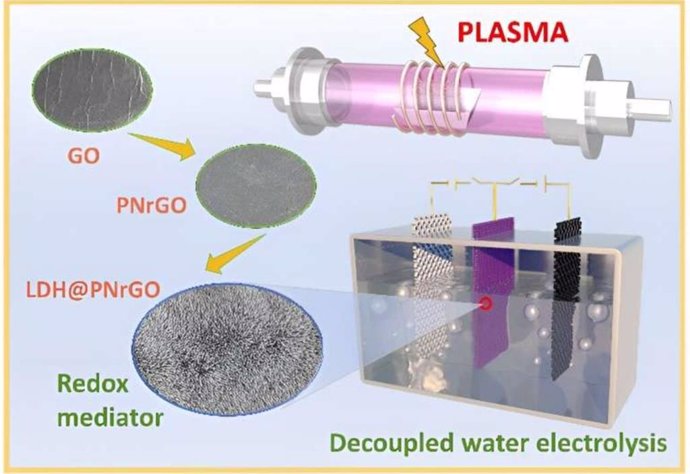Plasma-assisted preparation of high-capacity bipolar electrodes for hydrogen production by two-step water electrolysis. – CHEN CHANGLUN
8 Jul. () –
Chinese scientists have developed new electrodes that will significantly improve efficiency and stability from two-stage water electrolysis for hydrogen production.
These are advanced nickel hydroxide electrodes doped with cobalt and non-noble metal catalysts, whose research is presented in the journals Chemical Engineering Journal and Journal of Colloid and Interface Science.
Traditional alkaline electrolyzers face problems such as mismatch with fluctuating renewable energy sources and high-pressure hydrogen-oxygen mixing, which limits their applications. Two-stage water electrolysis overcomes these problems by completely separating hydrogen and oxygen production in time and space using a bipolar electrode, eliminating the need for an expensive membrane separator.
The key is to develop high-performance bipolar electrode materials and efficient cell designs. However, commonly used nickel hydroxide electrodes have limitations in terms of electrical damping capacity and charge/discharge stability.
Researchers used a one-step electrodeposition method to fabricate flexible bipolar electrodes of cobalt-doped nickel hydroxide on carbon cloth. Cobalt doping improved conductivity and electronic storage performance, and avoided parasitic oxygen production during hydrogen production.
They also developed non-noble metal catalysts, including molybdenum-doped cobalt/nickel-cobalt oxide bifunctional electrodes and plasma-induced iron compounds, which showed high durability and activityThese electrodes allowed the production of hydrogen and oxygen at different times and locations by changing the direction of the current, resulting in low cell voltages, high decoupling efficiency, and high energy conversion efficiency.
To improve layered double hydroxide (LDH) electrodes, which suffer from limited capacity and poor conductivity/stability, researchers They used non-thermal plasma technology to fabricate nitrogen-doped nickel-cobalt LDH and nitrogen-doped reduced graphene oxide/nickel-cobalt LDH electrodes, which significantly improved the capacitance and conductivity.
Two-stage water electrolysis is promising for large-scale hydrogen storage and for applications such as 5G base stations and data centers. “Our performance indicators for two-stage water electrolysis for hydrogen production are in sync with advanced indicators worldwide, marking an important step toward industrial operation,” said Professor Chen Changlun of the Hefei Institutes of Physical Science.




![[Img #74130]](https://thelatestnews.world/wp-content/uploads/2024/10/Richard-Dawkins-The-scientist-who-changed-our-understanding-of-evolution-150x150.jpg)





![[Img #74130]](https://thelatestnews.world/wp-content/uploads/2024/10/Richard-Dawkins-The-scientist-who-changed-our-understanding-of-evolution-300x200.jpg)


Add Comment